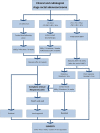Dose escalation using contact X-ray brachytherapy (Papillon) for rectal cancer: does it improve the chance of organ preservation?
- PMID: 28937269
- PMCID: PMC6047662
- DOI: 10.1259/bjr.20170175
Dose escalation using contact X-ray brachytherapy (Papillon) for rectal cancer: does it improve the chance of organ preservation?
Abstract
Objective: A watch and wait policy for patients with a clinical complete response (cCR) after external beam chemoradiotherapy (EBCRT) for rectal cancer is an attractive option. However, approximately one-third of tumours will regrow, which requires surgical salvage for cure. We assessed whether contact X-ray brachytherapy (CXB) can improve organ preservation by avoiding surgery for local regrowth.
Methods: From our institutional database, we identified 200 of 573 patients treated by CXB from 2003 to 2012. Median age was 74 years (range 32-94), and 134 (67%) patients were males. Histology was confirmed in all patients and was staged using CT scan, MRI or endorectal ultrasound. All patients received combined CXB and EBCRT, except 17 (8.5%) who had CXB alone.
Results: Initial cCR was achieved in 144/200 (72%) patients. 38/56 (68%) patients who had residual tumour received immediate salvage surgery. 16/144 (11%) patients developed local relapse after cCR, and 124/144 (86%) maintained cCR. At median follow up of 2.7 years, 161 (80.5%) patients were free of cancer. The main late toxicity was bleeding (28%). Organ preservation was achieved in 124/200 (62%) patients.
Conclusion: Our data suggest that CXB can reduce local regrowth to 11% compared with around 30% after EBCRT alone. Organ preservation of 62% achieved was higher than reported in most published watch and wait studies. Advances in knowledge: CXB is a promising treatment option to avoid salvage surgery for local regrowth, which can improve the chance of organ preservation in patients who are not suitable for or refuse surgery.
Figures









References
-
- Herrinton LJ, Altschuler A, McMullen CK, Bulkley JE, Hornbrook MC, Sun V, et al. Conversations for providers caring for patients with rectal cancer: comparison of long-term patient-centered outcomes for patients with low rectal cancer facing ostomy or sphincter-sparing surgery. CA Cancer J Clin 2016; 66: 387–97. - PMC - PubMed
-
- Renehan AG, Malcomson L, Emsley R, Gollins S, Maw A, Myint AS, et al. Watch-and-wait approach versus surgical resection after chemoradiotherapy for patients with rectal cancer (the OnCoRe project): a propensity-score matched cohort analysis. Lancet Oncol 2016; 17: 174–83. - PubMed
-
- Habr-Gama A, Gama-Rodrigues J, São Julião GP, Proscurshim I, Sabbagh C, Lynn PB, et al. Local recurrence after complete clinical response and watch and wait in rectal cancer after neoadjuvant chemoradiation: impact of salvage therapy on local disease control. Int J Radiat Oncol Biol Phys 2014; 88: 822–8. - PubMed
-
- Myint AS, Smith F, Whitmarsh K, Wong H, Pritchard M. Non surgical treatment of operable rectal cancer: Reducing harm from the standard of care in elderly patients. Eur JSurg Oncol 2016; 42: S228–S229Abstract 103.
Publication types
MeSH terms
LinkOut - more resources
Full Text Sources
Other Literature Sources
Medical

